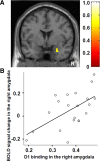Contribution of dopamine D1 and D2 receptors to amygdala activity in human
- PMID: 20181600
- PMCID: PMC6633940
- DOI: 10.1523/JNEUROSCI.5689-09.2010
Contribution of dopamine D1 and D2 receptors to amygdala activity in human
Abstract
Several animal studies have demonstrated functional roles of dopamine (DA) D1 and D2 receptors in amygdala activity. However, the contribution of DA D1 and D2 receptors to amygdala response induced by affective stimuli in human is unknown. To investigate the contribution of DA receptor subtypes to amygdala reactivity in human, we conducted a multimodal in vivo neuroimaging study in which DA D1 and D2 receptor bindings in the amygdala were measured with positron emission tomography (PET), and amygdala response induced by fearful faces was assessed by functional magnetic resonance imaging (fMRI) in healthy volunteers. We used multimodality voxelwise correlation analysis between fMRI signal and DA receptor binding measured by PET. DA D1 binding in the amygdala was positively correlated with amygdala signal change in response to fearful faces, but DA D2 binding in the amygdala was not related to amygdala signal change. DA D1 receptors might play a major role in enhancing amygdala response when sensory inputs are affective.
Figures


Similar articles
-
Human dopamine receptor D2/D3 availability predicts amygdala reactivity to unpleasant stimuli.Hum Brain Mapp. 2010 May;31(5):716-26. doi: 10.1002/hbm.20900. Hum Brain Mapp. 2010. PMID: 19904802 Free PMC article.
-
Dopaminergic Modulation of Lateral Amygdala Neuronal Activity: Differential D1 and D2 Receptor Effects on Thalamic and Cortical Afferent Inputs.Int J Neuropsychopharmacol. 2015 Feb 25;18(8):pyv015. doi: 10.1093/ijnp/pyv015. Int J Neuropsychopharmacol. 2015. PMID: 25716776 Free PMC article.
-
Striatal D1- and D2-type dopamine receptors are linked to motor response inhibition in human subjects.J Neurosci. 2015 Apr 15;35(15):5990-7. doi: 10.1523/JNEUROSCI.4850-14.2015. J Neurosci. 2015. PMID: 25878272 Free PMC article.
-
PET radioligands for the dopamine D1-receptor: Application in psychiatric disorders.Neurosci Lett. 2019 Jan 19;691:26-34. doi: 10.1016/j.neulet.2018.03.007. Epub 2018 Mar 5. Neurosci Lett. 2019. PMID: 29518542 Review.
-
Functional significance of central D1 receptors in cognition: beyond working memory.J Cereb Blood Flow Metab. 2012 Jul;32(7):1248-58. doi: 10.1038/jcbfm.2011.194. Epub 2012 Jan 11. J Cereb Blood Flow Metab. 2012. PMID: 22234338 Free PMC article. Review.
Cited by
-
Dopamine D₁ receptors and nonlinear probability weighting in risky choice.J Neurosci. 2010 Dec 8;30(49):16567-72. doi: 10.1523/JNEUROSCI.3933-10.2010. J Neurosci. 2010. PMID: 21147996 Free PMC article.
-
The amygdala: inside and out.F1000 Biol Rep. 2011 Jan 14;3:2. doi: 10.3410/B3-2. F1000 Biol Rep. 2011. PMID: 21399763 Free PMC article.
-
Synergistic activation of dopamine D1 and TrkB receptors mediate gain control of synaptic plasticity in the basolateral amygdala.PLoS One. 2011;6(10):e26065. doi: 10.1371/journal.pone.0026065. Epub 2011 Oct 14. PLoS One. 2011. PMID: 22022509 Free PMC article.
-
Modulative effects of COMT haplotype on age-related associations with brain morphology.Hum Brain Mapp. 2016 Jun;37(6):2068-82. doi: 10.1002/hbm.23161. Epub 2016 Feb 27. Hum Brain Mapp. 2016. PMID: 26920810 Free PMC article.
-
Bidirectional regulation of synaptic plasticity in the basolateral amygdala induced by the D1-like family of dopamine receptors and group II metabotropic glutamate receptors.J Physiol. 2014 Oct 1;592(19):4329-51. doi: 10.1113/jphysiol.2014.277715. Epub 2014 Aug 8. J Physiol. 2014. PMID: 25107924 Free PMC article.
References
-
- Abi-Dargham A, Simpson N, Kegeles L, Parsey R, Hwang DR, Anjilvel S, Zea-Ponce Y, Lombardo I, Van Heertum R, Mann JJ, Foged C, Halldin C, Laruelle M. PET studies of binding competition between endogenous dopamine and the D1 radiotracer [11C] NNC 756. Synapse. 1999;32:93–109. - PubMed
-
- Asan E. The catecholaminergic innervation of the rat amygdala. Adv Anat Embryol Cell Biol. 1998;142:1–118. - PubMed
-
- Bissière S, Humeau Y, Lüthi A. Dopamine gates LTP induction in lateral amygdala by suppressing feedforward inhibition. Nat Neurosci. 2003;6:587–592. - PubMed
-
- Brett M, Anton J, Valabregue R, Poline J. Region of interest analysis using the MarsBar toolbox [abstract]. Paper presented at 8th International Conference on Functional Mapping of the Human Brain; Sendai, Japan. 2002.
Publication types
MeSH terms
Substances
LinkOut - more resources
Full Text Sources
